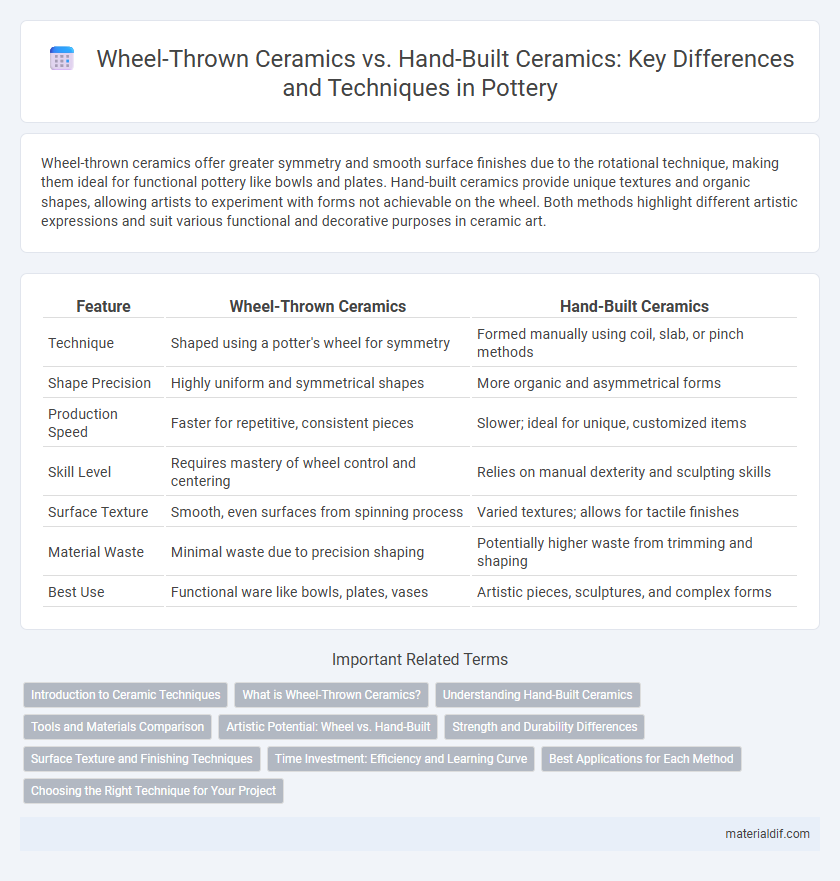Wheel-thrown ceramics offer greater symmetry and smooth surface finishes due to the rotational technique, making them ideal for functional pottery like bowls and plates. Hand-built ceramics provide unique textures and organic shapes, allowing artists to experiment with forms not achievable on the wheel. Both methods highlight different artistic expressions and suit various functional and decorative purposes in ceramic art.
Table of Comparison
| Feature | Wheel-Thrown Ceramics | Hand-Built Ceramics |
|---|---|---|
| Technique | Shaped using a potter's wheel for symmetry | Formed manually using coil, slab, or pinch methods |
| Shape Precision | Highly uniform and symmetrical shapes | More organic and asymmetrical forms |
| Production Speed | Faster for repetitive, consistent pieces | Slower; ideal for unique, customized items |
| Skill Level | Requires mastery of wheel control and centering | Relies on manual dexterity and sculpting skills |
| Surface Texture | Smooth, even surfaces from spinning process | Varied textures; allows for tactile finishes |
| Material Waste | Minimal waste due to precision shaping | Potentially higher waste from trimming and shaping |
| Best Use | Functional ware like bowls, plates, vases | Artistic pieces, sculptures, and complex forms |
Introduction to Ceramic Techniques
Wheel-thrown ceramics utilize a potter's wheel to shape clay into symmetrical forms, allowing for precise control and uniformity in design. Hand-built ceramics involve techniques such as coiling, pinching, and slab building, offering greater flexibility for organic shapes and intricate textures. Both methods require mastery of clay properties and firing processes to achieve durability and desired finishes.
What is Wheel-Thrown Ceramics?
Wheel-thrown ceramics refer to pottery created using a potter's wheel, which allows for symmetrical and smooth forms by shaping the clay as it spins. This technique enables precise control over thickness and shape, resulting in uniform and refined pieces such as bowls, vases, and plates. Wheel-thrown ceramics often exhibit consistent curves and professional finishes that differentiate them from more textured, irregular hand-built ceramics.
Understanding Hand-Built Ceramics
Hand-built ceramics are created using manual techniques such as coiling, pinching, and slab construction, allowing for greater artistic flexibility and unique shapes not achievable on a potter's wheel. This method emphasizes the tactile connection between the artist and clay, fostering organic textures and intricate surface details. Unlike wheel-thrown ceramics, hand-building is ideal for sculptural pieces and irregular forms that highlight the craftsperson's individual creativity.
Tools and Materials Comparison
Wheel-thrown ceramics primarily require a potter's wheel, various shaping tools like ribs and trimming tools, and fine clay with consistent plasticity to maintain form during rapid rotation. Hand-built ceramics utilize basic tools such as fingers, coils, slabs, wire cutters, and simple shaping aids, working well with a broader range of clays including grogged or coarse types for texture. The difference in tools directly impacts material choices, as wheel-thrown ceramics demand finer, more pliable clay bodies for smooth, symmetrical results, while hand-building tolerates rougher materials for diverse, organic shapes.
Artistic Potential: Wheel vs. Hand-Built
Wheel-thrown ceramics offer symmetrical forms and smooth surfaces ideal for functional and refined artistic expressions, allowing precise control over shape and uniformity. Hand-built ceramics provide unmatched flexibility for creating organic shapes, intricate textures, and sculptural forms that emphasize individuality and creative experimentation. Both techniques enhance artistic potential by catering to different aesthetic intentions and artistic styles within ceramic art.
Strength and Durability Differences
Wheel-thrown ceramics typically exhibit greater structural uniformity due to the even compression during the spinning process, resulting in enhanced strength and durability. In contrast, hand-built ceramics often show variable thickness and may contain weak points from uneven pressure application, making them generally less resilient to stress. The controlled, symmetrical form of wheel-thrown pieces contributes to a higher resistance to cracking and chipping compared to the often organic and textured nature of hand-built ceramics.
Surface Texture and Finishing Techniques
Wheel-thrown ceramics typically exhibit smoother, more uniform surface textures due to the centrifugal force shaping the clay, allowing for precise finishing techniques like trimming and burnishing. Hand-built ceramics often showcase varied textures with organic, tactile qualities derived from pinching, coiling, or slab construction methods, offering surface finishes such as scoring or layering that emphasize artistic expression. The choice between wheel-throwing or hand-building directly impacts the ceramic piece's tactile feel and visual intricacy, influencing glazing and firing outcomes.
Time Investment: Efficiency and Learning Curve
Wheel-thrown ceramics typically require less time to produce individual pieces compared to hand-built ceramics due to the spinning wheel's efficiency in shaping symmetrical forms. The learning curve for wheel throwing demands practice to master control and speed, making initial attempts slower but improving rapidly with experience. Hand-built ceramics offer more creative flexibility but usually involve a longer time investment per piece, as techniques like coiling or slab building are more labor-intensive and less repetitive than wheel throwing.
Best Applications for Each Method
Wheel-thrown ceramics excel in creating symmetrical, round forms such as bowls, vases, and cups, making them ideal for functional pottery requiring uniformity and fine detail. Hand-built ceramics offer greater flexibility for sculptural, asymmetrical, or large-scale pieces, allowing artists to experiment with textures and complex shapes not achievable on a wheel. Choosing between wheel-thrown and hand-built techniques depends on the desired form, precision, and artistic expression in the ceramic project.
Choosing the Right Technique for Your Project
Wheel-thrown ceramics offer precise symmetry and smooth surfaces, ideal for creating functional pottery like bowls and vases with consistent shapes. Hand-built ceramics provide more creative freedom for unique, sculptural forms using techniques such as coiling, pinching, or slab building, making them perfect for artistic and custom projects. Selecting the right technique depends on the desired final form, functionality, and the artist's skill level in wheel throwing or hand-building methods.
Wheel-thrown ceramics vs Hand-built ceramics Infographic

 materialdif.com
materialdif.com